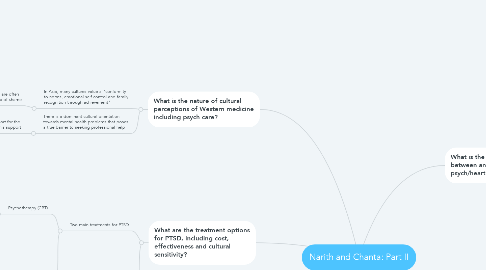
1. Panic Disorder can be associated with cardiac disease or mistaken for a heart attack
1.1. These feelings of extreme agitation and terror are often accompanied by dizziness, chest pains, stomach discomfort, shortness of breath and rapid heart rate
2. What is the nature of cultural perceptions of Western medicine including psych care?
2.1. In Asia, many cultures value a "conformity to norms, emotional self-control and family recognition through achievement"
2.1.1. That means that mental illnesses are often stigmatized and seen as a source of shame
2.2. There is a dominant cultural orientation towards mental health problems that poses a true barrier to seeking professional help
2.2.1. This stigma acts as a barrier to professional mental health support for the individuals who currently need this support
3. What are the treatment options for PTSD, including cost, effectiveness and cultural sensitivity?
3.1. Two main treatments for PTSD
3.1.1. Psychotherapy (CBT)
3.1.1.1. Main components of CBT consist of
3.1.1.1.1. Exposure therapy- Helps people face and control fears by exposing them to trauma memory in the context of a safe environment
3.1.1.1.2. Cognitive Restructuring- Helps people make sense of bad memories
3.1.1.2. Treatment focused on the main trauma event
3.1.1.3. Identifies, understands and tries to change thinking and behavior patterns
3.1.1.4. Patient engages in weekly appointments for 12-16 weeks and learn skills applied to their symptoms
3.1.2. Medication
3.1.2.1. Typically include SSRIs, MAOI, and SNRIs
3.1.2.2. Can be done with or without CBT
3.2. Cost of treatment
3.2.1. Typically in the thousands to tens of thousands range
3.2.1.1. In a cost-effectiveness of treatment of PTSD study done by the Western University of Health Sciences, two hundred patients from 18 to 65 years old with PTSD were studied
3.2.1.1.1. Their average cost was around $6,000 to $8,000 dollars per year
4. What is the nature of differentiating between panic disorder and heart conditions?
4.1. Anxiety can have various effects on the heart
4.1.1. Rapid Heart Rate
4.1.2. Increased blood pressure
4.1.3. Decreased heart rate variability
4.2. These can be distinguished from heart attacks and conditions by their past medical history
4.2.1. The patient's age and previous history of panic attacks is a differentiator
4.2.1.1. Younger patients are more likely to be experiencing a panic attack
5. What is the relationship between anti-malarials and psych/heart side effects?
5.1. Common Side Effects of Anti-malarials
5.1.1. Generic nausea
5.1.2. Vomiting
5.1.3. Abdominal pain
5.1.4. Headaches
5.1.5. Also can cause increased heart rate
5.2. However, some specific anti-malarials are known to have more serious complications
5.2.1. Some can cause more psychiatric side effects
5.2.1.1. Mefloquine was known specifically that have potent psychotropic potential
5.2.1.1.1. Severe side effects included anxiety, panic attacks, paranoia, delusions, dissociative psychosis and anterograde amnesia
5.2.1.1.2. In addition, associated with violence and suicide
5.2.1.2. These diverse psychiatric side effects are now understood as manifestations of a single underlying pathophysiological process characterized as toxic limbic encephalopathy
5.2.1.2.1. These acute effects appear to affect limbic and related structures and spared much of the cortex
5.2.1.2.2. This would specifically affect generation of emotions, reward mechanisms, sexual drive and formation of long-term memories such as fear
6. What different screening tests exist for PTSD/depression in specific patient populations (ie trauma from different causes)?
6.1. There are a few PTSD screens used to help diagnose people who are at a higher risk of PTSD
6.1.1. -Primary Care PTSD Screen for DSM-5- 5-item screen designed for use in primary care settings
6.1.2. -SPAN (Startle, Physically upset by reminders, Anger and Numbness)- 4-item self-report screen derived from Davidson Trauma Scale
6.1.3. -SPRINT (Short Post-Traumatic Stress Disorder Rating Interview)- Eight-item self-report measure that assesses core symptoms of PTSD
6.1.4. -TSQ (Trauma Screening Questionnaire)- 10-item symptom screen that is designed of use with survivors of traumatic stress
6.2. For special populations there are other screening tests:
6.2.1. Children: CARTS (Childhood Attachment and Relational Trauma Screen)- Survey of individuals' recollections of the quality of relationships with their family members during childhood and of relational traumatic experiences in childhood
